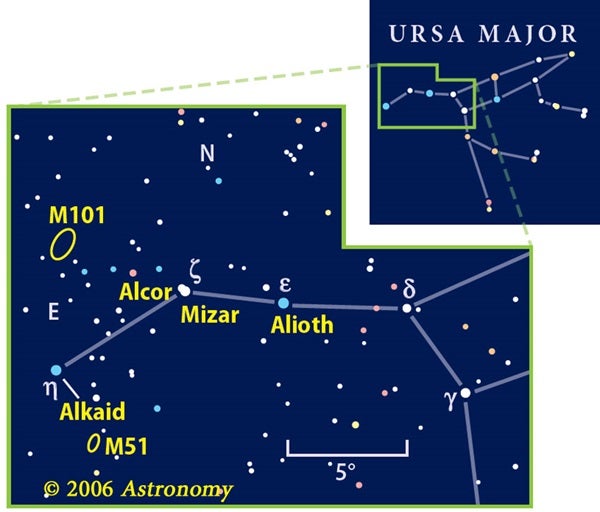The Big Dipper is not a constellation by itself, but rather part of Ursa Major the Great Bear. The Dipper’s bowl forms the Bear’s back and belly, while artists often portray the three stars in the Dipper’s handle — Alioth, Mizar, and Alkaid — as its long tail. But bears don’t have long tails.
The “pot” is the star Alcor. With Mizar, they form one of the sky’s best-known
double-star teams. They make a fun naked-eye test and are an easy target for even the smallest binoculars. Mizar shines at 2nd magnitude, while Alcor glows at 4th.
They may look like a physical pair, but Alcor and Mizar are actually frauds. Mizar lies 78 light-years from us, while Alcor is 81 light-years away. Mizar turns out to be a true close-set binary star, but you’ll need a telescope to see its companion.
Don’t confuse that for a third, fainter star that forms a tiny triangle with Alcor and Mizar. Although this star is not physically related to either, it holds an interesting footnote in astronomical history. In 1722, German mathematician Johann Liebknecht thought he saw this star move against the background from 1 night to the next. He concluded it was not a star, but a new planet. In his excitement, he christened it Sidus Ludoviciana (“Ludwig’s Star”) after Ludwig V, then king of Germany. It quickly became apparent that Liebknecht was mistaken, but the star is still called Sidus Ludoviciana.
If M101 proves a little too tough, try your luck with a brighter galaxy. Aim toward Alkaid, the star at the end of the Dipper’s handle. Look half a field to Alkaid’s west-southwest for a 4th-magnitude star, and then, from there, move an equal distance farther south to a pentagon of dimmer suns. If you look carefully just inside the pentagon’s eastern corner, you might spot a dim glow. That’s M51, the beautiful Whirlpool Galaxy.
Through 70mm and larger binoculars, you might notice M51 appears a little lopsided. You aren’t looking at just one galaxy, but two. Charles Messier missed M51’s companion, so you won’t find it in his catalog. We know it today as NGC 5195, its listing in the New General Catalogue. NGC 5195 glows at about 10th magnitude.
Let’s wrap things up with a reminder. In the March issue, I mentioned how Saturn was near M44, the Beehive Cluster in Cancer. The pair continues to form a pretty sight through binoculars. As a bonus, the crescent Moon joins them May 31. All three will fit nicely into the same binocular view as the sky darkens after sunset.
Come on back next month. We’ll visit the sky’s strongman, who has a few celestial surprises of his own. Till then, remember: Two eyes are better than one.











